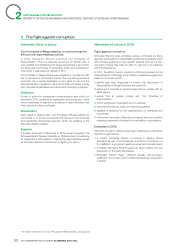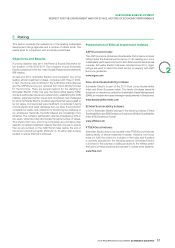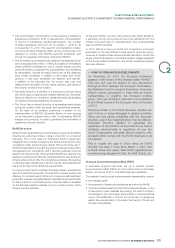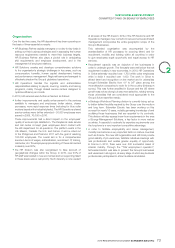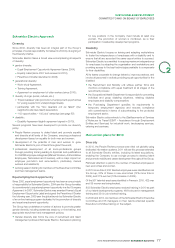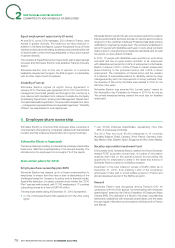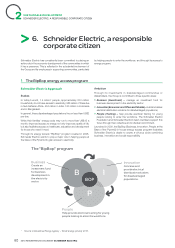APC 2010 Annual Report Download - page 72
Download and view the complete annual report
Please find page 72 of the 2010 APC annual report below. You can navigate through the pages in the report by either clicking on the pages listed below, or by using the keyword search tool below to find specific information within the annual report.
SUSTAINABLE DEVELOPMENT
2SCHNEIDER ELECTRIC’S COMMITMENT TOENVIRONMENTAL PERFORMANCE
The majority of these PEPs will be brought into compliance with
the demands of the PEP Ecopassport program, an environmental
declaration program which complies with the ISO14025 standard
launched in 2010. The program, which covers all electrical and
HVAC equipment for buildings, infrastructure and industry, attests
compliance with prevailing standards and practices. Schneider
Electric is chairing the program and its Steering Committee, and has
led the drafting of the governance rules and the PEPs, the articles of
association managing by the program.
Schneider Electric’s product development process complies with
“IEC 62430 – Environmentally Conscious Design for Electrical and
Electronic Products” – and is based on a multi-criteria lifecycle
analysis.
End-of-life guides
Schneider Electric takes end-of-life environmental impact into
account when designing products, going beyond the simple
calculation of potential recovery rates provided by Environmental
Impact and Management Explorer (EIME) software. The Group has
developed a guide of good design practices to optimise end-of-life
costs and the potential recyclability rate.
In 2010, Schneider Electric included recommendations and good
practices for environmentally friendly end-of-life processing in its
product instruction manuals. At the end of 2010, about 40% of
the turnover generated from global commercial products was from
products whose end-of-life information is available online.
5 Eco-Production
Schneider Electric’s Approach
Schneider Electric wants to have more sites with an environmental
management and reporting system, contributing to the Group’s
objectives. Priority objectives for 2009-2011 to increase the number
of employees working in ISO14001 certifi ed sites and to reduce its
energy consumption were set within the framework of the Planet &
Society Barometer for the whole Group. The certifi cation objective
helps focus continuous efforts to reduce the main environmental
impacts of the sites, shown in the table on pages 97-98:
•amount of waste produced;
•percentage of waste recovered;
•consumption of energy;
•consumption of water;
•CO2 emissions;
•VOC emissions (Volatile Organic Compounds).
Main Plans of Action in 2010
ISO14001 certification of Group sites
As soon as the ISO14001 environmental management standard was
published in 1996, Schneider Electric decided to certify its sites. For
several years the Group has demanded that all industrial and logistic
sites with more than 50 people be ISO14001 certifi ed within two
years of their acquisition or creation.
The extension of this internal directive to all tertiary sites with more
than 300 people was enacted in the One program from 2009
onwards and actually launched in 2010. The headquarters of the
Group in France, in Rueil-Malmaison, was thus certifi ed in 2010.
The Group’s priority objective, as set out in the Planet & Society
Barometer, is to enable two thirds of employees to work in
ISO14001 certifi ed sites. In 2010 the objective was exceeded: 69%
of employees worked on ISO 14001-certifi ed sites.
In 2010, the rate of certifi ed industrial sites is nearly achieved: 251
sites covering 82,373 people (including all the people working for
Schneider Electric on the site) were ISO14001 certifi ed at the end
of 2010.
For 2011 the challenge is to certify the new sites within two years
of their acquisition or creation and to continue the new certifi cations
of large tertiary sites.
Management of industrial consumption
Water consumption
The Group provides a detailed breakdown of water consumption that
takes into account groundwater and water from the public network.
Water used solely for cooling and then immediately released without
any change can also be included in the statistics.
Schneider Electric reports on the quantities of water consumed
by its sites on a six-monthly basis and monitors the per capita
consumption of water on a like-for-like basis in order to evaluate its
performance from one year to the next.
The overall eco-production approach allowed the Group to reduce its
per capita consumption of water by 6.5% in 2010 in relation to 2009
on a like-for-like basis. The Group has not deployed any specifi c
Group action plan in this area in 2010.
Energy consumption
See Reduction of CO2 emissions, page 64, and Energy savings,
page 66.
Raw material consumption
Schneider Electric focuses on making its devices more compact
to conserve natural resources so that customers have more
environmentally friendly products to choose from. The Group
has developed design tools for managing thermal and electrical
constraints so that it can optimise the amount of materials required
in production. Each device’s Product Environmental Profi le lists the
materials used. To facilitate end-of-life processing, Schneider Electric
chooses materials that are easy to recycle and clip-together systems
that are easy to disassemble. Life cycle analyses and recyclability
assessments also help the Group identify areas for improvement.
Schneider Electric has not had any specifi c Group action plan in
this area in 2010.
2010 REGISTRATION DOCUMENT SCHNEIDER ELECTRIC70


